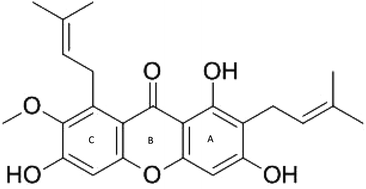当前位置:
X-MOL 学术
›
Food Funct.
›
论文详情
Our official English website, www.x-mol.net, welcomes your
feedback! (Note: you will need to create a separate account there.)
An anti-inflammatory molecular mechanism of action of α-mangostin, the major xanthone from the pericarp of Garcinia mangostana: an in silico, in vitro and in vivo approach
Food & Function ( IF 5.1 ) Pub Date : 2018-06-01 00:00:00 , DOI: 10.1039/c8fo00439k Syam Mohan 1, 2, 3, 4, 5 , Suvitha Syam 2, 3, 6, 7 , Siddig Ibrahim Abdelwahab 2, 3, 4, 5 , Neelaveni Thangavel 2, 3, 4, 8, 9
Food & Function ( IF 5.1 ) Pub Date : 2018-06-01 00:00:00 , DOI: 10.1039/c8fo00439k Syam Mohan 1, 2, 3, 4, 5 , Suvitha Syam 2, 3, 6, 7 , Siddig Ibrahim Abdelwahab 2, 3, 4, 5 , Neelaveni Thangavel 2, 3, 4, 8, 9
Affiliation

|
α-Mangostin (αMN) is a xanthone present in the pericarp of Garcinia mangostana Linn. which is mentioned in Ayurveda and is a widely used functional food supplement. However, its anti-inflammatory mechanism is not well studied. Hence, we used in silico, in vitro and in vivo models to provide information of the mechanism on how αMN could prevent inflammation. Firstly, molecular docking was used to find out the binding energy of αMN with NFκB and COX proteins. Secondly, LPS induced RAW 264.7 cells were used to measure the production of cytokines, the prevention of translocation of NFκB and the inhibition of COX-1 and -2 enzymes. Finally, carrageenan-induced peritonitis was used in vivo to check cytokine release, leukocyte migration and vascular permeability. The in silico modelling had showed that αMN has the lowest binding energy with COX-2 and NFκB proteins. αMN has been found to inhibit the production of PGE2 and nitric oxide, and iNOS protein expression. TNF-α and IL-6 cytokines were inhibited significantly (p < 0.05) at 8 and 14 μg ml−1 concentration. αMN at higher doses inhibits the translocation of NFκB together with suppressing the COX-2 enzymes, but not COX-1. αMN inhibited the total leukocyte migration, predominantly, neutrophils in vivo. The level of TNFα and IL-1β was significantly (p < 0.05) reduced in the peritoneal fluids as measured by ELISA analysis. Taken together, these results demonstrate that αMN acts well as an anti-inflammatory agent via inhibiting the hallmark mechanisms of inflammation. It can be considered as a potential alternative lead compound. In addition, the current results support the traditional use of this fruit pericarp as a functional food.
中文翻译:

芒果藤果皮主要主要蒽酮α-芒果的抗炎分子机制:计算机,体外和体内方法
α-Mangostin(αMN)是存在于藤黄果皮中的x吨酮。阿育吠陀中提到的它是一种功能广泛的功能性食品补充剂。但是,其抗炎机制尚未得到很好的研究。因此,我们用在硅片,在体外和体内模型来提供αMN如何预防炎症的机制的信息。首先,通过分子对接的方法发现αMN与NFκB和COX蛋白的结合能。其次,LPS诱导的RAW 264.7细胞用于测量细胞因子的产生,预防NFκB的移位以及抑制COX-1和-2酶的表达。最后,在体内使用角叉菜胶诱发的腹膜炎检查细胞因子释放,白细胞迁移和血管通透性。将在硅片建模已经表明αMN与COX-2和NFκB蛋白最低的结合能量。已经发现αMN抑制PGE 2和一氧化氮的产生以及iNOS蛋白的表达。在8和14μgml -1浓度下,TNF-α和IL-6细胞因子被显着抑制(p <0.05)。较高剂量的αMN抑制NFκB的转运,同时抑制COX-2酶,但不抑制COX-1。αMN抑制体内白细胞的总迁移,主要是中性粒细胞的迁移。TNFα和IL-1β的水平显着(p通过ELISA分析测得的腹膜积液中的<0.05)减少。综上所述,这些结果表明αMN通过抑制炎症的标志性机制而很好地用作抗炎剂。可以认为它是潜在的替代铅化合物。另外,目前的结果支持这种果皮作为功能食品的传统用途。
更新日期:2018-06-01
中文翻译:

芒果藤果皮主要主要蒽酮α-芒果的抗炎分子机制:计算机,体外和体内方法
α-Mangostin(αMN)是存在于藤黄果皮中的x吨酮。阿育吠陀中提到的它是一种功能广泛的功能性食品补充剂。但是,其抗炎机制尚未得到很好的研究。因此,我们用在硅片,在体外和体内模型来提供αMN如何预防炎症的机制的信息。首先,通过分子对接的方法发现αMN与NFκB和COX蛋白的结合能。其次,LPS诱导的RAW 264.7细胞用于测量细胞因子的产生,预防NFκB的移位以及抑制COX-1和-2酶的表达。最后,在体内使用角叉菜胶诱发的腹膜炎检查细胞因子释放,白细胞迁移和血管通透性。将在硅片建模已经表明αMN与COX-2和NFκB蛋白最低的结合能量。已经发现αMN抑制PGE 2和一氧化氮的产生以及iNOS蛋白的表达。在8和14μgml -1浓度下,TNF-α和IL-6细胞因子被显着抑制(p <0.05)。较高剂量的αMN抑制NFκB的转运,同时抑制COX-2酶,但不抑制COX-1。αMN抑制体内白细胞的总迁移,主要是中性粒细胞的迁移。TNFα和IL-1β的水平显着(p通过ELISA分析测得的腹膜积液中的<0.05)减少。综上所述,这些结果表明αMN通过抑制炎症的标志性机制而很好地用作抗炎剂。可以认为它是潜在的替代铅化合物。另外,目前的结果支持这种果皮作为功能食品的传统用途。











































 京公网安备 11010802027423号
京公网安备 11010802027423号